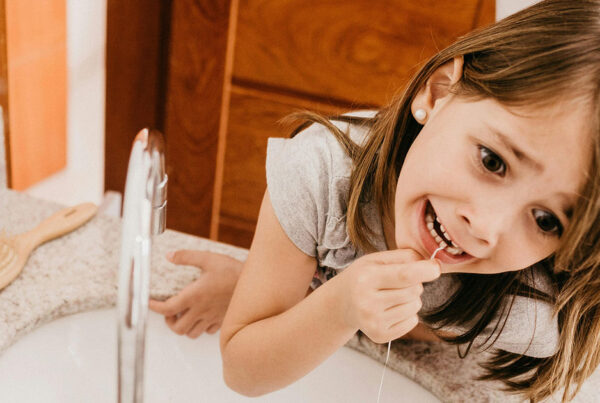When it comes to oral hygiene, most people focus on brushing and flossing, but there’s another simple yet powerful step you might be missing: tongue scraping! While tongue scraping may seem relatively new to those in North America, it’s actually been practiced for centuries in India, Europe, Africa and other parts of the world.
Tongue scraping involves using a tool to remove the buildup of bacteria, dead skin cells and food debris that forms on the tongue, which is a major culprit behind bad breath. This leaves your mouth fresher, cleaner and healthier.
But does it really work? And how do you use a tongue scraper properly? The team at our Vancouver dental studio will answer those questions and more in this blog post.
What is a Tongue Scraper?
A tongue scraper is an oral hygiene tool used to remove the coating on the tongue.
Some look like inverted spoons, while others are more U-shaped. But what they all have in common is that, unlike a toothbrush, they’re designed specifically to accommodate the tongue’s large surface area and spongy texture.
Why Use a Tongue Scraper?
The tongue is one of the main sources of bad breath (halitosis). The surface of your tongue, particularly the back portion, harbors bacteria, fungi, dead skin cells and food particles. If not removed, as the oral debris breaks down, it produces smelly compounds, including volatile sulfur compounds, that result in bad breath.
The Benefits of Tongue Scraping
- Fresher Breath – A systematic review published in the International Journal of Dental Hygiene concluded that mechanical approaches to tongue cleaning, such as using a tongue cleaner or scraper, removed tongue coating and odor-causing bacteria more effectively than brushing alone.¹
- Better Taste – Studies, including one in the Journal of Clinical Periodontology, suggest that tongue scraping can enhance your sense of taste by clearing away buildup.²
- Improved Oral Health – The tongue can be a reservoir for the harmful bacteria associated with cavities and periodontal disease, and it potentially plays a role in the bacteria recolonizing the tooth surfaces.³ Therefore, consistently removing bacteria with tongue scraping may help to reduce the risk of oral disease.
- A Healthier-Looking Tongue – Tongue scraping is effective at removing the whitish, yellowish coating on the tongue, leaving you with a healthy, pink tongue.¹
How to Use a Tongue Scraper Properly
Not sure how to scrape your tongue the right way? Follow these simple steps:
- After flossing and brushing, stick out your tongue and place the rounded edge of the tongue scraper at the back of your tongue.
- With the tongue scraper touching the surface of your tongue, use the handles to gently pull the scraper forward toward the tip of your tongue. Never push it backward!
- Rinse your tongue scraper with water after each pass to remove bacteria and debris.
- Repeat one or two more times until your tongue feels clean.
- Clean your tongue scraper with a mild dishwashing soap or non-abrasive toothpaste and rinse thoroughly with warm water. Let it air dry between uses.
Pro Tip: If you’re worried about gagging, start at the middle of your tongue and gradually work your way further back.
Cleaning a Tongue Scraper: What You Need to Know
Now that you know how to use a tongue scraper, let’s talk about how to clean it. Be sure to check the instructions that came with the product, as using the wrong type of cleaner could damage certain materials.
In general, you’ll want to wash it with a mild dish soap and thoroughly rinse it with warm water before allowing it to air dry after every use. It’s also good practice to wash your hands before and after scraping your tongue.
Most tongue scrapers can benefit from a deeper clean once a week. To do this, soak the tongue scraper in antibacterial mouthwash or a solution of water and denture cleaner for several minutes. If you have a plastic tongue scraper, replace it every three months.
Are All Tongue Scrapers the Same?
Nope! Tongue scrapers come in a variety of materials and designs, each with its own benefits:
- Plastic Scrapers – Lightweight and budget-friendly but need frequent replacing
- Stainless Steel Scrapers – More durable and easy to clean
- Copper Scrapers – Naturally antibacterial but require more upkeep
- Aluminium Scrapers – Light, pliable and long lasting
Looking for the best tongue scraper? We carry Gunkii tongue scrapers at Nest Dental because we love the combo of precision and quality. Ask us about them at your next visit!
Common Tongue-Scraping Myths (Debunked!)
- Myth: Brushing your tongue is just as effective as scraping.
Fact: Toothbrushes are designed for the hard surfaces of the teeth and not the soft, crevice-filled surface of the tongue. A 2004 study compared tongue cleaning using a toothbrush vs. a tongue scraper.⁴ The researchers found that the tongue scraper removed 30% more bad-breathing-causing compounds than the toothbrush. - Myth: Scraping once in the morning is enough to prevent bad breath all day.
Fact: While tongue scraping is effective, bacteria quickly build back up on the tongue throughout the day. Scraping after every meal, or at least twice a day, will give you the best results. - Myth: Scraping is harsh and damages your tongue.
Fact: If done correctly, tongue scraping is safe and painless. Just avoid pressing too hard!
Should You Add Tongue Scraping to Your Routine?
Absolutely! Incorporating a tongue cleaner or scraper into your daily routine is an easy way to elevate your oral hygiene, fight bad breath and keep your mouth feeling fresh and clean.
That said, if you have a “hairy tongue,” persistent bad breath or white patches in your mouth, you should visit the dentist for an evaluation. Though the benefits of tongue scraping are plentiful, it’s not a cure for oral disease.
Freshen Your Breath and Boost Your Oral Health at Nest Dental
A clean tongue is just one piece of the puzzle when it comes to optimal oral hygiene. Pairing tongue scraping with regular dental exams, cleanings and expert care ensures your smile stays healthy and vibrant.
Ready to take your oral health to the next level? Book an appointment at Nest Dental in Vancouver today!
Sources:
- Van der Sleen, MI, et al. Effectiveness of mechanical tongue cleaning on breath odour and tongue coating: a systematic review. International Journal of Dental Hygiene. 8, 2010; 258–268. https://doi.org/10.1111/j.1601-5037.2010.00479.x
- Quirynen, M., et al. Impact of tongue cleansers on microbial load and taste. Journal of Clinical Periodontology. 31, 2004; 506-510. https://doi.org/10.1111/j.0303-6979.2004.00507.x
- Faveri, Marcel, et al. Microbiota of the dorsum of the tongue after plaque accumulation: an experimental study in humans. Journal of Periodontology. 77, 2006; 1539-1546. https://doi.org/10.1902/jop.2006.050366
- Pedrazzi, Dr. Vinicius, et al. Tongue-cleaning methods: a comparative clinical trial employing a toothbrush and a tongue scraper. Journal of Periodontology. 75, 2004, 1009-1012. https://doi.org/10.1902/jop.2004.75.7.1009




